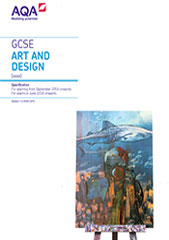3.7 Textile design
Textile design is defined here as the creation of designs and products for woven, knitted, stitched, printed or decorative textiles that might have a functional or non-functional purpose.
Areas of study
In Component 1 and Component 2 students are required to work in one or more area(s) of textile design, such as those listed below:
- art textiles
- fashion design and illustration
- costume design
- constructed textiles
- printed and dyed textiles
- surface pattern
- stitched and/or embellished textiles
- soft furnishings and/or textiles for interiors
- digital textiles
- installed textiles.
They may explore overlapping areas and combinations of areas.
Knowledge, understanding and skills
Students must develop and apply the knowledge, understanding and skills specified in the Subject content to realise personal intentions relevant to textile design and their selected area(s) of study.
The following aspects of knowledge, understanding and skills are defined in further detail to ensure students’ work is clearly focused and relevant to textile design.
Knowledge and understanding
The way sources inspire the development of ideas, relevant to textile design including:
- how sources relate to cultural, social, historical, contemporary, environmental and creative contexts which might be determined or influenced by functional or non-functional considerations
- how ideas, feelings, forms, and purposes can generate responses that address personal needs or meet external requirements, such as client expectations and any associated constraints.
The ways in which meanings, ideas and intentions relevant to textile design can be communicated include the use of:
- figurative and non-figurative representations, stylisation, simplification, surface embellishment, constructional considerations and imaginative interpretation
- visual and tactile elements, such as:
- colour
- line
- form
- tone
- texture
- shape
- pattern
- composition
- decoration
- repetition
- scale
- structure
- surface.
Skills
Within the context of textile design, students must demonstrate the ability to:
- use textile design techniques and processes, appropriate to students’ personal intentions,
for example:
- weaving
- felting
- stitching
- appliqué
- construction methods
- printing.
- use media and materials, as appropriate to students’ personal intentions, for example:
- inks
- yarns
- threads
- fibres
- fabrics
- textile materials
- digital imagery.
